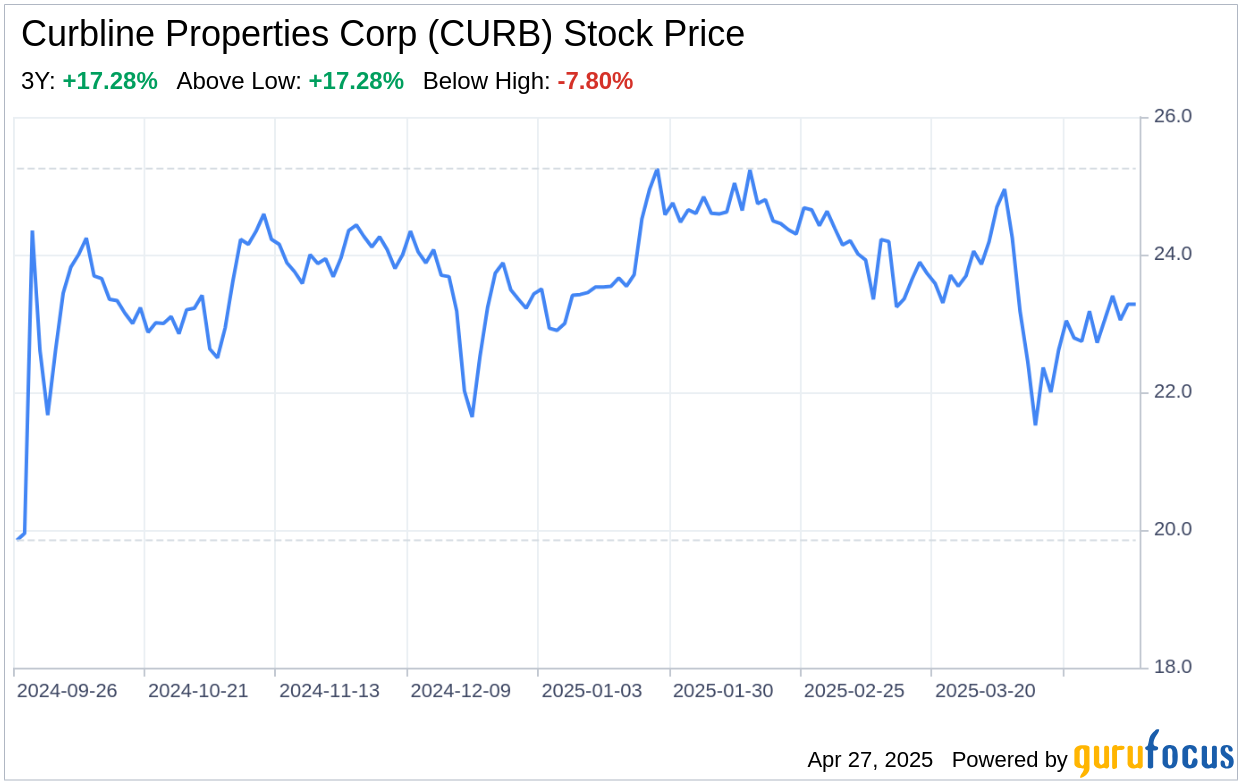On April 25, 2025, Curbline Properties Corp (CURB, Financial) released its 10-Q filing, revealing a company in the midst of strategic growth and financial strengthening. CURB, specializing in the ownership, management, and leasing of convenience shopping centers, has shown a notable increase in assets from $2.03 million in December 2024 to $2.12 million in March 2025. The company's net income has also seen a healthy uptick, rising from $7.975 million in the first quarter of 2024 to $10.562 million in the same period of 2025. This financial overview sets the stage for a deeper SWOT analysis, providing investors with a comprehensive understanding of CURB's market position and strategic direction.

Strengths
Portfolio Expansion and Financial Health: CURB's strength lies in its aggressive portfolio expansion, having grown to 107 convenience shopping centers with a gross leasable area (GLA) of 3.4 million square feet. This expansion is backed by a robust balance sheet, evidenced by a net increase in total real estate assets from $1.26 million in December 2024 to $1.38 million in March 2025. The company's financial health is further highlighted by a significant cash and cash equivalents position of $594,038, providing ample liquidity for further acquisitions and operations.
Revenue Growth and Profitability: CURB's revenue from operations has seen a substantial increase, with rental income jumping from $27,866 in Q1 2024 to $38,438 in Q1 2025. This revenue growth has translated into increased profitability, with net income growing from $7.975 million to $10.562 million over the same period. The company's ability to enhance its income streams while maintaining a strong profit margin is a testament to its operational efficiency and strategic leasing practices.
Weaknesses
Operational Costs and Debt Levels: Despite its financial growth, CURB faces challenges with rising operational costs, as evidenced by the increase in operating and maintenance expenses from $2,932 to $5,402, and real estate taxes from $3,021 to $4,821 in the first quarter year-over-year. Additionally, the company's indebtedness, albeit modest at $98,988, requires careful management to ensure it does not impede financial flexibility or lead to increased financial leverage.
Dependence on Tenant Diversity: CURB's success hinges on its diversified tenant base, which, while a strength, also poses a risk. The company must continuously attract and retain a mix of national, regional, and local tenants to maintain its revenue streams. Any significant tenant turnover or inability to lease to high-credit-quality tenants could adversely affect CURB's financial performance and occupancy rates.
Opportunities
Market Positioning and Acquisition Strategy: CURB's unique market positioning as a publicly traded real estate company focused exclusively on the convenience real estate sector presents significant growth opportunities. With a net cash position and access to debt capital, CURB is well-equipped to scale its asset base through strategic acquisitions, tapping into the highly fragmented but liquid marketplace for convenience shopping centers.
Demographic Trends and Tenant Mix: CURB's properties are situated in suburban areas with high household incomes, aligning with demographic trends favoring convenience and service-oriented retail. The company's focus on leasing to a diversified group of service and restaurant businesses positions it to capitalize on consumer preferences for convenience and experiential retail, potentially driving above-average cash flow growth.
Threats
Economic Uncertainty and Tenant Solvency: The retail industry is susceptible to economic downturns, which can impact tenant solvency and lead to increased vacancies. CURB must navigate these challenges by closely monitoring tenant credit profiles and being prepared to backfill spaces vacated by bankrupt or non-renewing tenants. The company's ability to maintain high occupancy rates in the face of economic uncertainty is crucial to its continued success.
Interest Rate Fluctuations and Capital Market Volatility: As a real estate investment trust (REIT), CURB is exposed to interest rate fluctuations and capital market volatility. While the company has mitigated some risk through interest rate swaps, unfavorable changes in interest rates or capital markets could impact the cost of capital and the return on investments, potentially affecting CURB's growth trajectory and financial performance.
In conclusion, Curbline Properties Corp (CURB, Financial) exhibits a strong financial foundation and strategic market positioning, with a growing portfolio and robust revenue streams. However, the company must address operational cost management and maintain tenant diversity to sustain its competitive edge. Opportunities for expansion through acquisitions and favorable demographic trends present significant potential for growth, while economic uncertainties and interest rate fluctuations pose risks that require vigilant management. CURB's forward-looking strategies, including its focus on convenience shopping centers and a diversified tenant mix, position it well to leverage its strengths and capitalize on market opportunities while mitigating inherent weaknesses and external threats.
This article, generated by GuruFocus, is designed to provide general insights and is not tailored financial advice. Our commentary is rooted in historical data and analyst projections, utilizing an impartial methodology, and is not intended to serve as specific investment guidance. It does not formulate a recommendation to purchase or divest any stock and does not consider individual investment objectives or financial circumstances. Our objective is to deliver long-term, fundamental data-driven analysis. Be aware that our analysis might not incorporate the most recent, price-sensitive company announcements or qualitative information. GuruFocus holds no position in the stocks mentioned herein.
